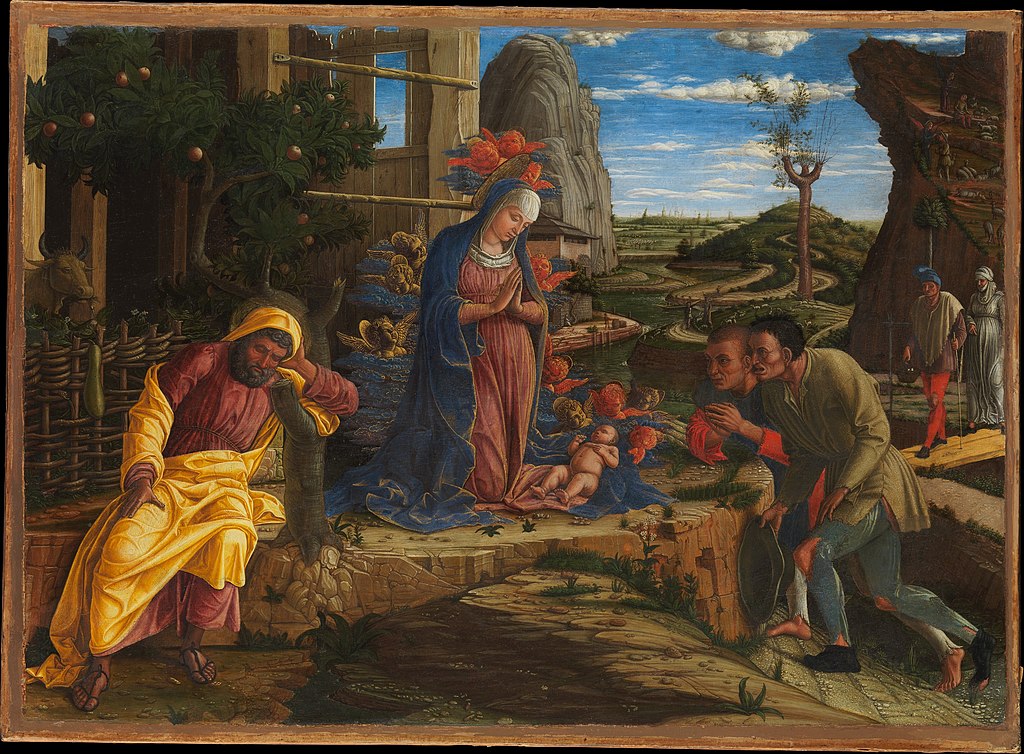The painting is to be considered an extraordinary work by Mantegna. The small size of the board in relation to the chromatic and compositional richness of the work alludes to the fertile period of the Ferrara miniature.
Andrea Mantegna is attested in Ferrara in 1449 when he painted a double portrait, now lost, of Leonello and Folco da Villafora, his chamberlain. The sacred and traditional theme of the adoration of shepherds is here declined following the common forms of everyday life in which one can recognise oneself. The figures of the shepherds have not been softened to become part of the composition, their faces are furrowed by wrinkles and they wear old, torn clothes reflecting the condition of the time. They are depicted in the act of kneeling with joined hands and hat in hand, behind them two other shepherds are preparing to approach to pay homage to the Saviour, bearing a humble basket full of eggs. In the centre of the composition is painted the Virgin Mary kneeling with her gaze turned towards her son, lying on his cloak, both of whom are surrounded by many red and gold cherubs emerging from slender clouds with golden reflections. The balance of the composition is maintained by the figure of the sleeping Saint Joseph on the left counterbalancing that of the two shepherds on the right. The Saint, wearing beautiful coloured robes, is slumbering leaning against a tree laden with fruit, but one also notices that the tree has two broken branches, probably an allusion to the Child’s fate.
The most striking aspect of this Adoration is the depiction of the landscape and its details depicted with extreme reality, so much so as to recall the style of a Flemish composition. The landscape is composed of harsh and rocky stretches contrasting with green and gentle areas, the river flows sinuously between two arid spurs of rock. The right side of the painting is teeming with life: a figure on the riverbank waits for a boat, while others are intent on tending animals, on the right a shepherd with his flock is visited by an angel. Behind the Virgin is a humble wooden construction, probably the stable, from which a ruminating ox appears on the left. Here is the most important element for hypothesising the commissioner of the work: Mantegna has painted a fence on which a pumpkin hangs, but it is not just any fence, it is a paraduro, which was taken as an emblem by Borso d’Este. This type of fence was used to protect fields from river flooding and a ‘violina’ pumpkin (so called because of its elongated shape, just like the one in the depiction) was often tied to it, which when emptied was used as a hydrometer: the vegetable followed the water level and rising warned of the impending flood. The paraduro is therefore associated with the drainage of the marshy territories of Ferrara and was therefore a much-used symbol of Borso, only his most loyal court dignitaries had the honour of wearing it embroidered on their robes.
At the time of the Devolution of Ferrara (1598) the painting took the road to Rome and became part of the Aldobrandini collection, where it remained until the early 19th century when it was purchased by the English art dealer and painter Alexander Day. After various passages it was bought by the great antiquarian Joseph Duveen and ended up in New York.







